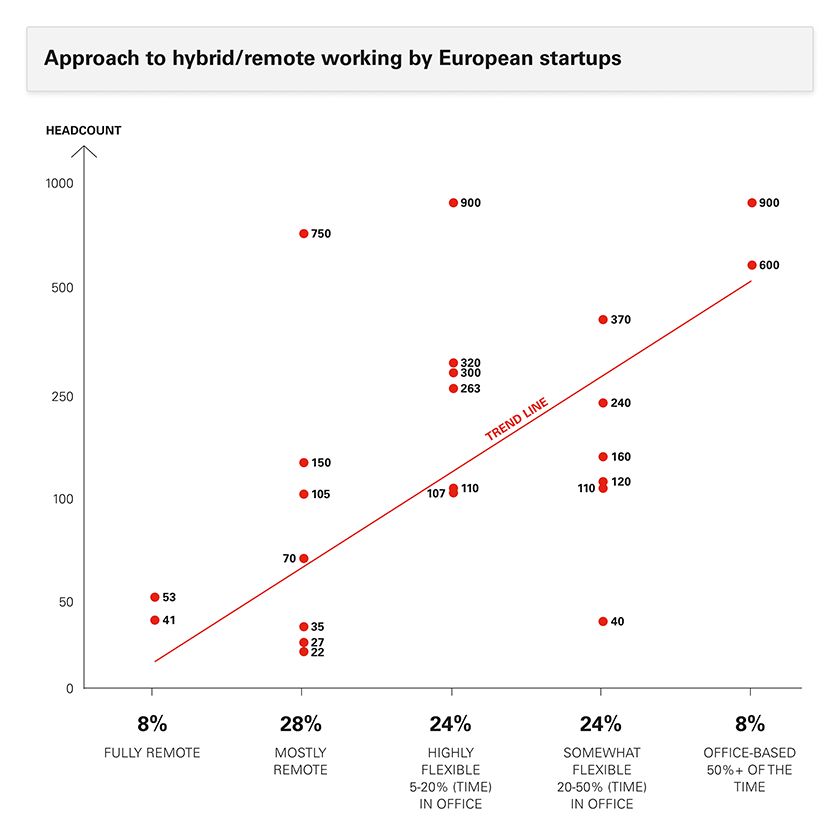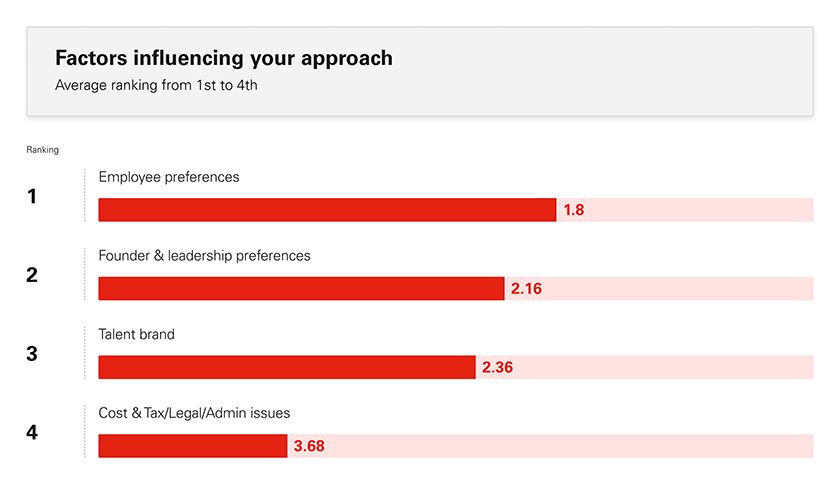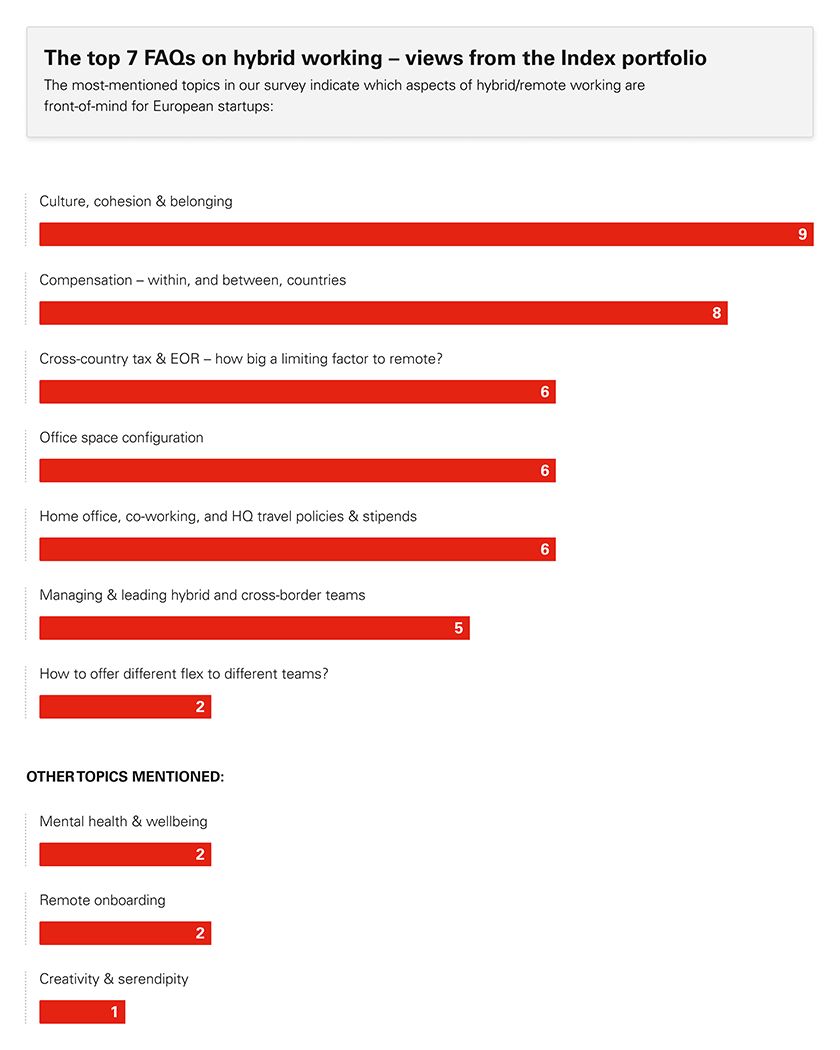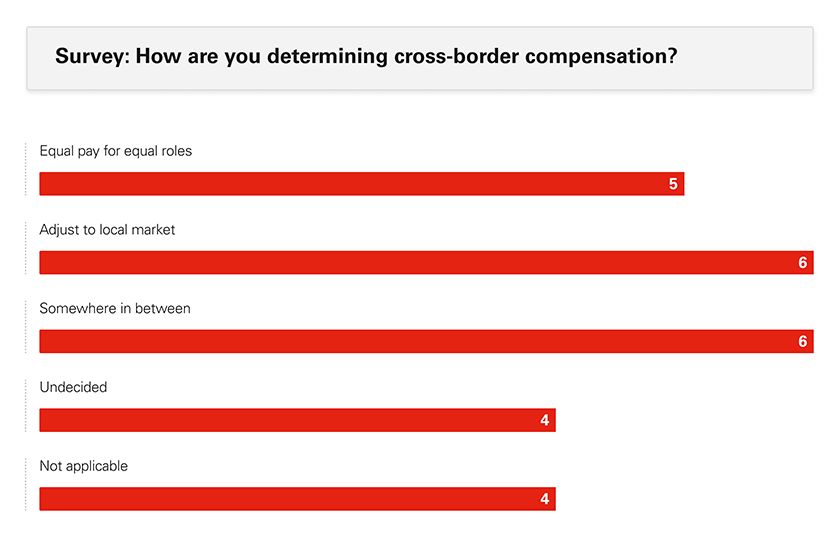Will Europe's startups return to offices after covid?

Coming through the pandemic, tech startups continue to demonstrate their agility and capacity for innovation. The vast majority of Index portfolio companies are moving to highly-flexible setups, supporting and enabling remote work, while also allowing for in-office working. They are embracing the benefits for their employees that have become evident these past 12 months, and are experimenting with a range of policies, tools, and suppliers, to address the downsides.
"This last year has actually been a terrible way to experience remote working - there are childcare challenges, no opportunities for team gatherings, and no social life upside from working-from-home" - Job van der Voort, Remote
Surprisingly few startups are shifting to fully-remote models, primarily out of concern for impacting collaboration and culture, which are both so critical in the early life of companies.
Whilst predictions are always dangerous to make, I would argue that startups are increasingly shaping patterns in the wider world of work. As a result, I expect many larger organisations to slowly-but-surely follow the example of the startups featured here, shifting towards increasingly flexible work-from-anywhere approaches. Whilst this shift is limited by sector-specific factors - manufacturing, transportation, construction, caring, policing, etc all still require physical presence - it reflects fundamental human preferences about how we ideally want to work and live. And as our expectations of work shift, this will only accelerate the uptake of new technologies (e-commerce, telemedicine, drone deliveries, autonomous vehicles, pre-fabrication, vertical farming...) that enable a larger proportion of humanity to work remotely and flexibly.
The view from the Index portfolio
The question about how to organise work faces all European entrepreneurs today, and the answer will have profound consequences for culture, hiring plans, and finances. It was no surprise that during recent months, I’ve found myself in numerous 1-1 conversations about this topic, with founders and people leaders in the Index family. In search of more robust data, I decided to conduct a survey on the topic, followed by a series of roundtables.
25 Index-backed startups participated from across Europe (plus one from Australia), ranging in scale from Seed to post-IPO, and from 22 to 900 headcount.
We also benefited from the expertise of Job van der Voort, founder & CEO of Remote.com, (disclosure - an Index portfolio company) that provides friction-free international payroll, benefits and compliance services.
Five Flavours of hybrid and remote setup
We defined a spectrum of approaches to hybrid/remote working:
- Fully remote - no offices at all
- Mostly remote - but with a minority of people or teams working from a company office
- Highly flexible, but not remote - all (or nearly all) employees live within reach of a company office, with expectation of 5-20% time on-site
- Somewhat flexible - all (or nearly all) team members expected to spend 20-50% of their time in a company office
- Office-based - some wfh expected, but all (or nearly all) will work from a company office 50%+ of the time
What we found
Only 32% have already committed to an approach
Only 8 of 25 companies (32%) have already chosen their post-covid approach, and have communicated this to their employees. 28% are piloting a specific approach, and 40% are still evaluating the alternatives.
Only 8% anticipate a return to 50%+ time in-office
There is no single approach that stands out for the startups in our survey. Only two (8%) have moved to being fully-remote, with another two (8%) anticipating a return to majority (50%+) time working from company offices. Two more (8%) are still undecided. The remaining 19 (76%) expect some degree of hybrid/remote working. There is a loose, and perhaps unsurprising, correlation that the smaller the company, the more radical the shift towards remote or flex working versus remaining office-centric.

Engineering teams may lead the way
10 (40%) of the startups expect their engineering teams to move faster and further to remote, versus 7 (28%) who are introducing remote-working across all teams.
What are the big tech companies doing?
Many major tech companies have now announced their post-covid plans for remote & hybrid working. Whilst they are messaging a more flexible approach, the reality is that all the FAANGM giants are shifting back to a majority-office setup. A number of second-tier tech majors, however, have publicly announced more radical moves towards remote-working, no doubt driven by the war to attract and retain talent.
- Expecting 50%+ time in office - Apple, Netflix, Google, Uber, Microsoft, Twilio.
- Allowing remote for a portion of engineering - Zillow, Facebook.
- Supportive of remote - Spotify, Twitter, Shopify, Dropbox, Square, Atlassian, Okta, Robinhood. These companies will support, but won't require, working from an office.
- Fully remote - No major tech companies have (yet) announced a move to fully-remote as a result of covid. The pre-existing high profile examples remain GitLab, Zapier, and Automattic.
Three factors are shaping the decision
Preferences - both those of employees and founders/leadership - are driving the decision making process. Enhancing talent brands followed closely behind. Cost and tax/legal/admin complexity, came a distant fourth.

Everyone is facing a split in employee preferences revealed in surveys. The large majority want a blended approach, but with minorities in favour of going fully-remote or fully returning to the office. As a result, you can't please everybody. Even if you offer full flexibility whilst retaining your office space, many people will choose to stay away, thereby diluting the office-experience for those who do choose to come in.
"There's no going back - only a minority want to work fully in an office now. Employees will expect companies to offer them the choice. Companies will need to adapt to this change, or risk losing great talent" - Anna Fredrixon, Chief People Officer, Kry
Tips for handling the shift to permanent hybrid-working

Each of these top 7 topics was discussed during our roundtable sessions. There was no "perfect answer" for how to handle each. Instead, below is a summary of suggestions and perspectives that different participants shared...
1. Culture, cohesion, and belonging
"There's no such thing as a hybrid culture... you either embrace remote culture, or you will suffer and ultimately fail" - Job van der Voort, Remote
Have your leadership demonstrate that hybrid-working is acceptable, by working remotely some or all of the time
Conduct all meetings, even in the office, via individual video from desks, unless they are 1-1.
Admit to your employees that you don't have all the answers yet - and engage them in crafting solutions to what are difficult challenges.
Set up open audio-channels where people can hang out (eg Discord, "Hangout in Hangouts"). Or go further, with virtual-office software such as Teamflow, Gather, or Branch.gg.
"When working from home, your sense of belonging shifts somewhat from your colleagues, to your family & friends & local community. This is part of the appeal of remote work. Companies should embrace this rather than seeing it as a threat" - Anonymous
Shifting to a culture of documentation is critical. Build a single source of truth in a Company Handbook. This requires establishing new habits - there are no magic bullets, it's about endless repetition, and enforcement of the rules, which must be followed by all. Make this a key element of onboarding, and role-model it continuously from the top.
With a distributed workforce, periodic in-person gatherings are extremely valuable. These should be for 3-5 days, quarterly or annually. Include at least one annual full-company event, with more frequent gatherings at the leadership or function level. A heavy emphasis should be placed on socialising, and providing unstructured time. Whilst there is no ideal solution for inclusion, just do the best you can to enable all employees to attend.
2. Cross-border & within-country compensation
There is no perfect answer to this question. Your policy approach will be determined by your overall compensation philosophy.

However, there was a reasonable level of agreement around...
- Equal pay for equal roles within a country, even if there are cross-border differences.
- Equal equity for equal roles, even if cash comp is different.
“If someone relocates from a major city to a smaller - and cheaper - town, it’s hard to downgrade their salary. After all, we wouldn’t dream of doing this if they moved from a city centre to the suburbs, or just to a cheaper city neighbourhood” - Anonymous
On benefits, some are levelling-up benefits between countries where it's practical (eg parental leave, vacation days, sick pay). Others are setting a (high) global minimum standard per benefit, which would be competitive in most countries - but going beyond this if expectations or statutory standards in a certain country are even higher.
Several companies have put in place a fixed global minimum salary for the company as a whole, regardless of role or country - at the $35-40k level.
Scarcity of roles is a major driver - eg data science & machine-learning roles are levelling upwards on a global basis, as are senior and executive roles in general.
Participants observed that US tech salaries are levelling-up towards one of the two main coastal hubs (Silicon Valley and New York), regardless of location. Greater workforce mobility is driving this - with employees more vocally resisting downgrades to their comp when they do relocate.
3. Cross-country tax & EOR
There is a fundamental global taxation issue - if you work 180+ days in another country, you become tax-resident there.
For the time being, authorities are pretty much turning a blind eye so monitoring & enforcing rules, so this has not posed a problem. But it will become important again, as covid restrictions are relaxed.
The EOR (employer-of-record) approach is generally becoming easier and more accepted - with the exception of Germany.
You should use a GEO such as Remote.com as a solution provider for EOR (including payroll, taxes, statutory filings, etc) across multiple countries.
Once you have (or intend to get to) a critical mass of employees in a certain country, it makes sense to create an entity there, versus using EOR. Critical mass varies by country, depending on how painful entity setup is. At the low-end, this might be 4-6 in the UK. Germany (uniquely) has restrictions on use of EOR beyond a 2 year period, so an entity is also likely to come sooner versus later. Some other countries might switch at 10+.
You need to set employee policies and limits around mobility. For example, 2 months max allowed in another country without company consent, and 1 year minimum-time commitment if changing country, or to elect to be fully-remote versus needing office-space. It’s just too costly and tricky to oversee otherwise.
Ultimately you have to trust people to follow your rules. In theory you could use GPS access to company devices to monitor where people are, but this is not advised, as it could hugely undermine trust.
There are also potential data and privacy issues with working overseas, eg GDPR if employees move outside of Europe. You need to balance risk versus strict compliance oversight, with extra caution if you are in a regulated industry such as fintech or healthtech.
"Strictly speaking, if you enter the US on a tourist visa, and check your emails on your phone whilst you're there, you're breaking the rules. But nobody really worries about this" - Anonymous
4. Office space configuration
Lots of companies are moving to hot-desking, and implementing systems for pre-booking desks (eg SpaceTailor.io, envoy.com). They are also reconfiguring space, breaking down walls to maximise collaboration space, with more meeting rooms, more zooming booths, and more social/sofa areas.
Some, however, are also applying limits to office days per week, to avoid breaking a remote-friendly culture. In some cases this means setting fixed-days for certain teams to assemble in the office for collaboration. With space constraints, this is generally not practical to extend to the whole-team. And if fixed-days in the office become too frequent or rigid, you could undermine your remote-first culture.
With fewer walls and more video-calls, it can make sense to provide noise-cancelling headphones, so that employees can work effectively in open-plan setups.
"We've been out of lockdown here in Australia for several months now. When we surveyed our employees pre-return, they said they'd expect to spend half their time back in the office, and we planned accordingly. In reality, they only came in once per week with no more than a handful at a time. This is slowly increasing now as confidence builds, so we’ll see how it evolves" - Anthony Zaccaria, LinkTree
Will we all find this to be true, and end up needing much less office space than we anticipate?
Some startups are already downsizing office space (eg if in WeWork), whilst others have scaled-back or pushed-back plans for new offices. With landlords under pressure, focus on obtaining maximum flexibility on break-clauses in lease agreements.
"Since closing our office, people are moving closer to their families, outside the city, or nearer to the sea. They are really enjoying the freedom" - Oliver Neumann, Cargo.One
5. Home offices, co-working, and stipends
Almost all companies are providing an allowance for kitting out home-offices, with pre-set standards for hardware and accessories that will be reimbursed. And with additional allowances for certain roles too - eg writing tablets & extra-large screens for designers.
"We provide an allowance for all wfh basics - ergonomic chair, desk, laptop, screen, webcam, peripherals, external mic, headphones" - Job van der Voort, Remote
Taxable-benefits issues can be painful. For small amounts, the use of Amazon vouchers can solve a lot of problems. At scale, you can use a benefits platform such as Twic.
Team budgets ($300/month) have also been offered, to support virtual events, or lunching with colleagues who live nearby.
Several companies have implemented shared-office (eg Desana subscription) or co-working budgets (eg a $250/month stipend) for all staff based remotely. A few are also considering ‘spoke offices’ in cities where they have 6+ (for example) employees.
HQ travel costs can vary markedly depending on where a certain employee is located, so flat-rate payments for all can be offered to all remote staff for office-travel. But this may need to vary, if specific employees are required to be in the office more regularly.
6. Managing & leading hybrid and cross-border teams
With distributed teams, you have to concentrate on output rather than input. Focus on setting goals, and then let people deliver on them. You also need to double-down on emphasising your values in performance reviews and assessments, with particular emphasis on the importance of over-communicating. Several companies are offering manager training on how to adapt to this.
Managing across wide time zones is particularly challenging. So try to keep the members of individual teams within +/-2hr timezone windows, to avoid damage to employees' home-life.
There were differing views when it came to the concept of 'core-hours' (eg 10am-3pm based on "HQ" time). Some participants felt this was good for promoting availability and communication. Others felt it undermined asynch workflows and the benefits of truly flexible remote working.
Several companies suggested that you should expect tighter spans of control when managing remote and distributed teams - eg maximum 5 direct reports, versus 7 for in-office teams.
7. Offering different levels of flexibility to different teams
Engineering teams are almost always keener on remote versus others, and this applies both to individuals, and to managers. This is nothing new. Since engineering is often where talent pools are tightest, this is also a lucky coincidence, since a remote-first approach can enhance your employer value proposition.
Sales teams, and more junior employees, tend to be least keen on remote working: Salespeople are more likely to enjoy the buzz and energy of co-location. Junior employees are keen to build relationships, in order to maximise their opportunities to learn from more experienced colleagues. They are also most likely to want the social benefits of a city centre, and least likely to have the space for a productive home-office setup.
"Do not leave remote/wfh policy decisions to individual managers' discretion" - Dominic Jacquesson, Index Ventures
These tensions are further driving hybrid-working policies, with resulting differences between teams and functions in how they play out. However, almost all participants agreed that decisions and principles around remote and home-working must be enforced top-down, even if they are drawn up collaboratively - they must become part of your company culture.
Published — May 19, 2021

